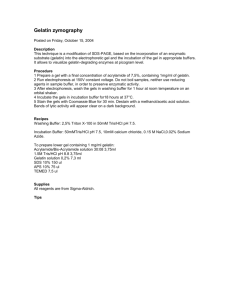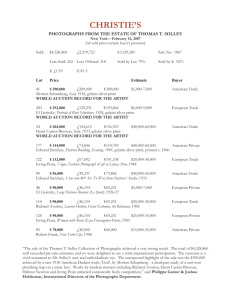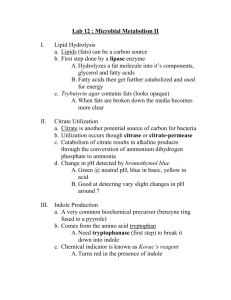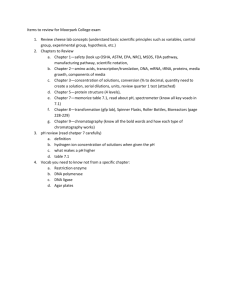Gelatin Hydrolysis Test Protocol
advertisement
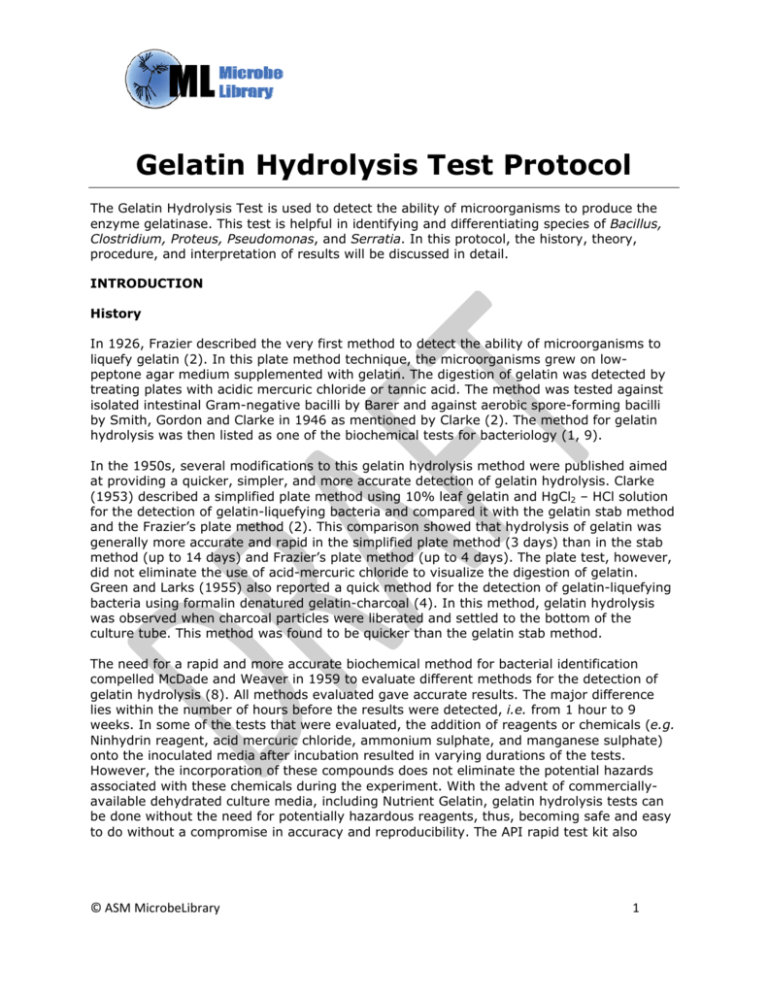
Gelatin Hydrolysis Test Protocol The Gelatin Hydrolysis Test is used to detect the ability of microorganisms to produce the enzyme gelatinase. This test is helpful in identifying and differentiating species of Bacillus, Clostridium, Proteus, Pseudomonas, and Serratia. In this protocol, the history, theory, procedure, and interpretation of results will be discussed in detail. INTRODUCTION History In 1926, Frazier described the very first method to detect the ability of microorganisms to liquefy gelatin (2). In this plate method technique, the microorganisms grew on lowpeptone agar medium supplemented with gelatin. The digestion of gelatin was detected by treating plates with acidic mercuric chloride or tannic acid. The method was tested against isolated intestinal Gram-negative bacilli by Barer and against aerobic spore-forming bacilli by Smith, Gordon and Clarke in 1946 as mentioned by Clarke (2). The method for gelatin hydrolysis was then listed as one of the biochemical tests for bacteriology (1, 9). In the 1950s, several modifications to this gelatin hydrolysis method were published aimed at providing a quicker, simpler, and more accurate detection of gelatin hydrolysis. Clarke (1953) described a simplified plate method using 10% leaf gelatin and HgCl2 – HCl solution for the detection of gelatin-liquefying bacteria and compared it with the gelatin stab method and the Frazier’s plate method (2). This comparison showed that hydrolysis of gelatin was generally more accurate and rapid in the simplified plate method (3 days) than in the stab method (up to 14 days) and Frazier’s plate method (up to 4 days). The plate test, however, did not eliminate the use of acid-mercuric chloride to visualize the digestion of gelatin. Green and Larks (1955) also reported a quick method for the detection of gelatin-liquefying bacteria using formalin denatured gelatin-charcoal (4). In this method, gelatin hydrolysis was observed when charcoal particles were liberated and settled to the bottom of the culture tube. This method was found to be quicker than the gelatin stab method. The need for a rapid and more accurate biochemical method for bacterial identification compelled McDade and Weaver in 1959 to evaluate different methods for the detection of gelatin hydrolysis (8). All methods evaluated gave accurate results. The major difference lies within the number of hours before the results were detected, i.e. from 1 hour to 9 weeks. In some of the tests that were evaluated, the addition of reagents or chemicals (e.g. Ninhydrin reagent, acid mercuric chloride, ammonium sulphate, and manganese sulphate) onto the inoculated media after incubation resulted in varying durations of the tests. However, the incorporation of these compounds does not eliminate the potential hazards associated with these chemicals during the experiment. With the advent of commerciallyavailable dehydrated culture media, including Nutrient Gelatin, gelatin hydrolysis tests can be done without the need for potentially hazardous reagents, thus, becoming safe and easy to do without a compromise in accuracy and reproducibility. The API rapid test kit also © ASM MicrobeLibrary 1 Gelatin Hydrolysis Test Protocol allows rapid detection of gelatin hydrolysis with the diffusion of black pigment within the cupule along with other biochemical tests. Purpose The gelatin hydrolysis test detects the ability of bacteria to produce gelatinases. This test aids in the identification of Serratia, Pseudomonas, Flavobacterium, and Clostridium (7, 11). It distinguishes the gelatinase-positive, pathogenic Staphylococcus aureus from the gelatinase-negative, non-pathogenic S. epidermidis (5). Gram-positive, spore-forming, rodshaped, aerobic or anaerobic bacteria such as Bacillus anthracis, B. cereus, B. subtilis, Clostridium perfringens and C. tetani, are also positive for gelatin hydrolysis (6). The test can also be used to differentiate genera of gelatinase-producing bacteria such Serratia and Proteus from other members of the family Enterobacteriaceae (6). Table 1. List of common bacteria and their reactions to the gelatin hydrolysis test performed on Nutrient Gelatin (3, 6). Species Bacillus subtilis Clostridium perfringens Escherichia coli Proteus vulgaris Serratia liquefaciens Staphylococcus aureus Growth + + + + + + Liquefaction + + + + + Theory Gelatin is a protein derived from the connective tissues of vertebrates, that is, collagen (6). It is produced when collagen is boiled in water (5). Gelatin hydrolysis detects the presence of gelatinases. Gelatinases are proteases secreted extracellularly by some bacteria which hydrolyze or digest gelatin (6). This process takes place in two sequential reactions. In the first reaction, gelatinases degrade gelatin to polypeptides (6). H20 Gelatinase Gelatin Polypeptides © ASM MicrobeLibrary 2 Gelatin Hydrolysis Test Protocol Then, the polypeptides are further converted into amino acids (6). H20 Gelatinase Polypeptides Amino Acids The bacterial cells can then take up these amino acids and use them in their metabolic processes. Gelatin hydrolysis is detected using a Nutrient Gelatin medium (5, 6). This medium contains peptic digest of animal tissue (peptone), beef extract, and gelatin (3). Gelatin serves as both solidifying agent and substrate for gelatinase activity. When Nutrient Gelatin tubes are stab-inoculated with a gelatinase-positive bacterium, the secreted gelatinases will hydrolyze the gelatin resulting in the liquefaction of the medium (6). Since gelatin is digested and is no longer able to gel, the medium will remain liquid when placed inside a refrigerator or in an ice bath (5). A Nutrient Gelatin medium inoculated with a gelatinase-negative bacterium will remain solid after the cold treatment. The medium can be inoculated with both aerobic and anaerobic bacteria and incubated as appropriate. RECIPE Nutrient Gelatin (3) Ingredients Peptone Beef extract Gelatin grams / liter 5.0 g 3.0 g 120.0 g Final pH: 6.8 ± 0.2 at 25°C Prepare media by mixing all ingredients in 1,000 mL of distilled or deionized water and heating gently to dissolve. Dispense 2-3 mL of media into 13 x 100 mm culture tubes. Autoclave medium at 121oC (15 psi) for 15 minutes. Allow the tubed medium to cool in an upright position before use. Store the prepared medium at 2-8 oC. Tubed media stored at 28 oC may be used until its expiration date. Do not use tubed medium if it shows signs of microbial contamination, discoloration, drying or other signs of deterioration (3). PROTOCOL Nutrient Gelatin stab method. There are several methods in determining gelatinase production, all of which make use of gelatin as the substrate. The standard and most commonly employed method is the Nutrient Gelatin stab method. This method offers an © ASM MicrobeLibrary 3 Gelatin Hydrolysis Test Protocol easy and accurate interpretation of results (medium liquefaction) and eliminates the use of reagents or chemicals that may be hazardous to health. Figure 1. A schematic diagram of gelatin hydrolysis test using the Nutrient Gelatin stab method. The use of screw-capped test tube is recommended. In this method, a heavy inoculum of an 18-24 hour old test bacteria is stab-inoculated into tubes containing Nutrient Gelatin (Fig. 1). The inoculated tubes and an uninoculated control tube are incubated at 25°C or at the test bacterium’s optimal growth temperature for up to 1 week, checking everyday for gelatin liquefaction. Gelatin normally liquefies at 28°C and above so to confirm that liquefaction was due to gelatinase activity, the tubes are immersed in an ice bath for 15-30 minutes. Afterwards, tubes are tilted to observe if gelatin has been hydrolyzed. Hydrolyzed gelatin will result in a liquid medium even after exposure to cold temperature (ice bath) while the uninoculated control medium will remain solid (Fig. 2). The hydrolysis of gelatin indicates the secretion of gelatinase by the test organism into the medium. Note that some bacterial species, e.g. Proteus vulgaris, may require up to 14 days of incubation to yield a positive result. Aseptic techniques and appropriate biosafety protocols should always be strictly observed and practiced in the microbiology laboratory. B A © ASM MicrobeLibrary 4 Gelatin Hydrolysis Test Protocol Figure 2. Gelatin hydrolysis test. After 30 minutes in an ice bath, Nutrient Gelatin tube inoculated with Bacillus subtilis exhibited positive gelatin hydrolysis as shown by medium liquefaction (A) while the uninoculated control remained solid (B). Gelatin hydrolysis was observed after three days of incubation. For weak positive results, incubate the inoculated Nutrient Gelatin tube longer until complete liquefaction is observed. For the Nutrient Gelatin stab method, it should be noted that some gelatinase-positive organisms produce the enzyme at a slower rate. Thus, the following tips are recommended: • Stab-inoculate Nutrient Gelatin tubes with a heavy inoculum of the test bacteria. • Incubate Nutrient Gelatin tubes for a longer period (7 days up to 14 days). • Use smaller test tubes for the Nutrient Gelatin medium (13 x 100 mm). • Use smaller volume of Nutrient Gelatin (2-3 ml) in the tubes. Nutrient Gelatin plate method. A suggested alternate test to detect gelatin hydrolysis is the Nutrient Gelatin plate method. In this method, a heavy inoculum of an 18-24 hour old test bacteria is stab-inoculated onto culture plates pre-filled with Nutrient Gelatin (23 g/L Nutrient Agar; 8 g/L 275 bloom gelatin). Inoculated Nutrient Gelatin plates are incubated at 35 oC for 24 hours. Gelatin hydrolysis is indicated by clear zones around gelatinase-positive colonies (Fig. 3). In some cases, plates are flooded with saturated ammonium sulphate to precipitate unhydrolyzed gelatin making the clear zones easier to see. Results are often observed within 5 – 10 minutes after flooding with saturated ammonium sulphate (Catherine Hopper, University of Maine, pers. comm.). Figure 3. Gelatin hydrolysis test using Nutrtient Gelatin plate method. Positive gelatin hydrolysis exhibited by Bacillus subtilis (A) indicated by the clear zone around the colony © ASM MicrobeLibrary 5 Gelatin Hydrolysis Test Protocol after the addition of saturated ammonium sulphate. Negative gelatin hydrolysis exhibited by Escherichia coli (B) indicated by the absence of clearing zone around the colony. Inoculated culture plates were incubated for 24 hours. Another suggested medium for Nutrient Gelatin plate method contains 4 g/L peptone, 1 g/L yeast extract, 12 g/L gelatin, and 15 g/L agar. In most cases, this medium gives visible zone without treatment of saturated ammonium sulphate (10). SAFETY The ASM advocates that students must successfully demonstrate the ability to explain and practice safe laboratory techniques. For more information, read the laboratory safety section of the ASM Curriculum Recommendations: Introductory Course in Microbiology and the Guidelines for Biosafety in Teaching Laboratories. REFERENCES 1. Clarke, P. H., and S. T. Cowan. 1952. Biochemical methods for bacteriology. J. Gen. Microbiol. 6:187-197. 2. Clarke, S. K. R. 1953. A simplified plate method for detecting gelatin-liquefying bacteria. J. Clin. Pathol. 6:246-248. 3. Difco & BBL Manual – Manual of Microbiological Culture Media, 2nd edition. 2009. Becton, Dickinson and Company, Maryland, USA. Pages 402-403. 4. Greene, R. A., and G. G. Larks. 1955. A quick method for the detection of gelatin liquefying bacteria. J. Bacteriol. 69:224. 5. Harley, J. P. 2005. Laboratory exercises in microbiology, 6th ed. McGraw-Hill Companies, Inc., New York, USA. 6. Leboffe, M. J., and B. E. Pierce. 2010. Microbiology laboratory theory and application, 3rd ed. Morton Publishing Company, Colorado, USA. 7. Madigan, M. T., J. M. Martinko, D. A. Stahl, and D. P. Clark. 2012. Brock biology of microorganisms, 13th edition. Benjamin Cummings, California, USA. 8. McDade, J. J., and R. H. Weaver. 1959. Rapid methods for the detection of gelatin hydrolysis. J. Bacteriol. 77: 60-64. 9. Schreckenberger, P. C., and D. J. Blazevic. 1974. Rapid methods for biochemical testing of anaerobic bacteria. Appl. Microbiol. 28(5):759-762. © ASM MicrobeLibrary 6 Gelatin Hydrolysis Test Protocol 10. Smith Jr, H. L., and K. Goodner. 1958. Detection of bacterial gelatinases by gelatinagar plate methods. J. Bacteriol. 76(6):662-665. 11. Willey, J. M., L. M. Sherwood, and C. J. Woolverton. 2008. Prescott’s microbiology, 8th ed. McGraw-Hill Companies, Inc., New York, USA. © ASM MicrobeLibrary 7
